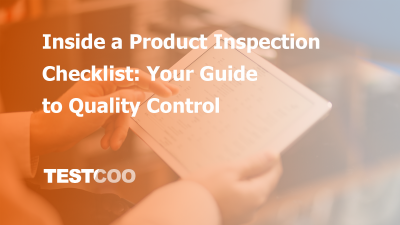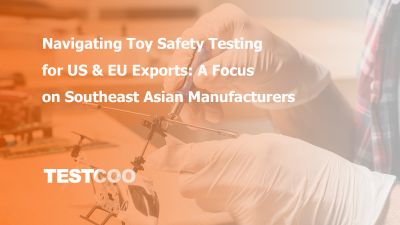5 Things You Probably Didn’t Know About Inspection Sampling
Whether you’ve been in the supply chain game for a while, or just getting into it, one of the most important questions is how do you make sure your goods meet your quality criteria? Checking every item is too costly and time-consuming, so inspecting random samples from production lots has become the norm.
What is AQL
AQL is defined by ISO 2859-1 and represents the Acceptable Quality Limit. Noted as the “quality level that is the worst tolerable,” it sets the standard for how many and to what extent defects are considered acceptable based on inspections of random samples of goods taken from the entire production lot.
There are three types of defects: minor, major, and critical.
Minor: a defect that won’t hinder the functionality of the product, or the end consumer’s need to return it. For example, a small scratch on the leg of a chair that can’t be seen would be considered a minor defect.
Major: examples include a cracked tablet face, a label for a pair of linen trousers that indicates they should be washed in hot water rather than cold, or a calculator with two of the same buttons.
Critical: examples include anything that could be a health hazard or life-threatening, either to the consumer or to anyone within the vicinity of the product. A critical defect could be a source of legal liability for you, the importer, or seller. A piece of furniture that does not stand, wearable garments with sharp pins or a severed thumb in a canned good would generally represent a critical defect.
Randomly testing samples from manufactured lots before shipping makes it easier to identify any defects and handle the situation quickly and efficiently.
What is the common approach to AQL?
Pro QC uses the ANSI ZI.4-2013 single normal sampling chart as a standard. There are several possible scenarios based on the tables.
First, you need to identify the inspection level. The most common is General Inspection Level II (see table below). Considerations for choosing inspection levels are outlined below.
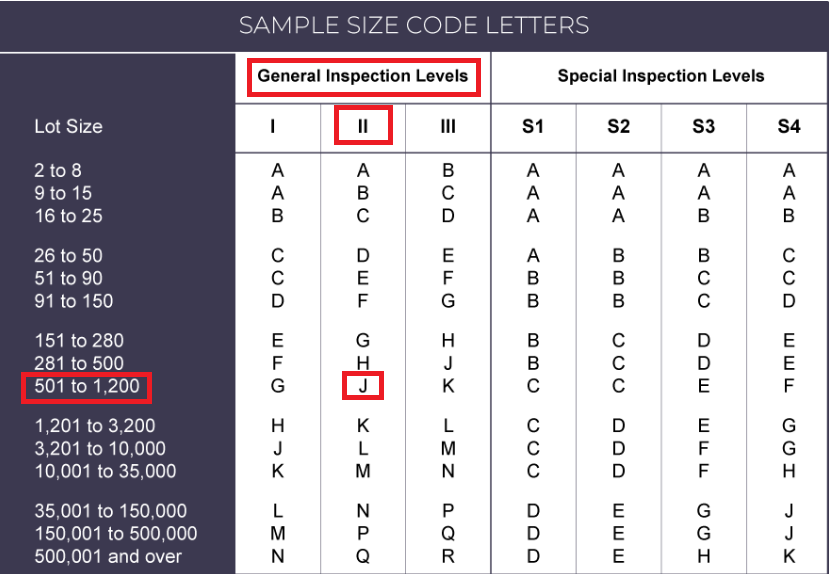
Once you’ve chosen your inspection level, it’s time to plug in some of the numbers. If production consists of 1000 widgets, how many do we inspect? Following the chart below, you’ll see that the recommendation will be to randomly pull 80 widgets out of the lot for inspection.
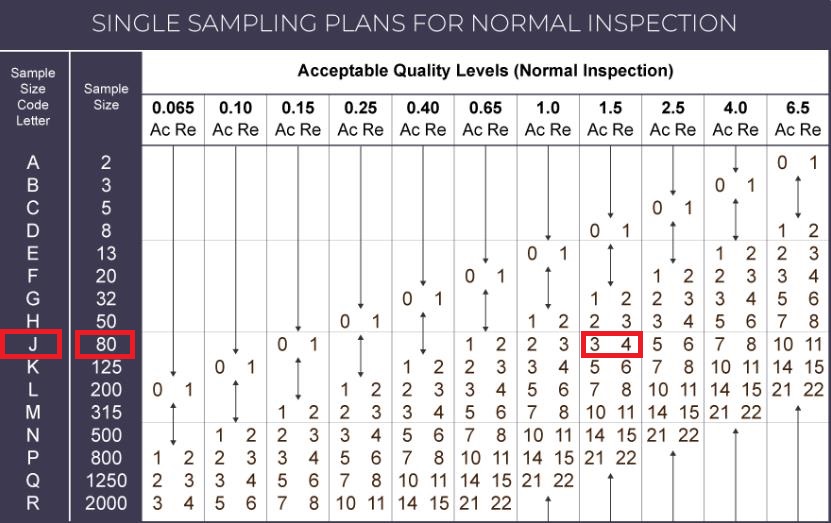
Finally, you need to choose your acceptable quality levels for critical, major, and minor defects. How many defects will still result in the shipment remaining acceptable for shipment?
What are the important things to keep in mind with AQLs?
There is no set-in-stone approach for your manufacturing lot. Once you’ve started the process, it becomes easier to tweak your strategy. As you develop a relationship with your manufacturer and work with them on inspection feedback, the process should be smoother.
Considerations for determining inspection levels include the lot size for sampling, the amount of time available, and the cost.
Other factors come into play, such as whether the conditions for production for this particular lot were exactly the same – i.e. the same shift, team, and raw materials. If yes, then the need for a larger sample size would be reduced. If it was produced by different lines, with different raw materials, then a greater sample size might be required.
What are the risks of reducing the sample size?
As noted, the biggest question for clients is how to balance risk and cost and therefore lot size with sample size, and the amount of time that will take without causing too much delay in getting products where they need to be.
For those with smaller batches in production, it is always a concern as to how much time, money, and effort is afforded to spend on getting samples randomly inspected for AQLs. However, reducing the sample size can also lead to legal repercussions, so it is important to consider the practical and legal perspective before deciding how many pieces will be evaluated.
- Why is following an AQL sampling Plan important?
The chart below depicts the risk associated with reducing the inspection sample size in certain situations. In our example, the client’s lot size is 12,000 pieces with an AQL of 1.5. At this AQL level, a 5% defect rate is accepted (i.e. combination of major & minor defects equalling 5%).
The recommended sample size is 315 pieces, and at this sampling rate, the chances of having a ‘false pass’ is just over 8% (see the blue curve below). A false pass implies that the sample defect rate is less than the acceptable rate (5% in our example), but the defect rate of the lot is, in fact, greater than the acceptable rate.
When sample sizes are reduced, the probability of a false pass increases. Reducing the sample sizes to 200 or further to 125 pushes the ‘false pass’ rate to 21% and 40% respectively. Of course, no sampling plan reduces consumer risk to zero, and relying on 100% inspections is cost-prohibitive. That said, AQL sampling is the generally accepted approach to balancing cost and risk. The sampling plan recommended should be adhered to unless special circumstances, such as those mentioned in the previous section, exist.
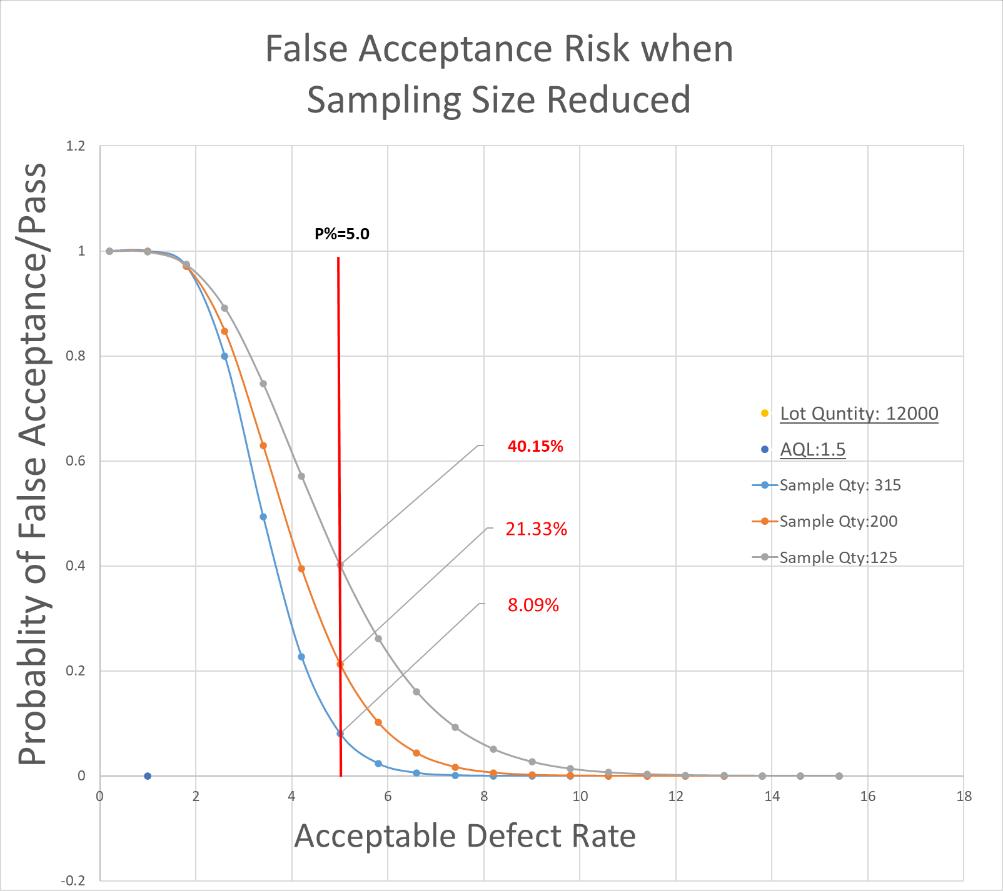
Note regarding quality control company liability: the above example shows that consumer risk is never zero, even when following the prescribed sampling plan. Even though it may be highly unlikely to occur, it is still possible for a buyer to receive a shipment with a higher than expected defect rate when the inspection report found the goods sampled to be within the acceptable limit. An inspection company can only be held liable where they were negligent in their performance of the service. Overall, QC inspections go a long way towards reducing risk, but the risk is never eliminated.
So, how do you get started with AQL?
Talk to the experts. Pro QC is a third-party quality assurance provider who assists both in guiding you toward the right level for your production and also with the random sampling inspections. Contact us with questions, or to discuss your specific quality requirements.
Free Sample Report Performance Quality Control
Download a sample report to keep control of your supply chain!
Featured Articles
 AQL Table | How to Read It
AQL Table | How to Read It TOP 10 Common Defects in Garments Quality Inspection
TOP 10 Common Defects in Garments Quality Inspection Product Packaging and Shipment Label requirements for Amazon FBA
Product Packaging and Shipment Label requirements for Amazon FBA What Is ASTM-F2413-18? Protective Footwear Standard
What Is ASTM-F2413-18? Protective Footwear Standard How to Conduct Third-Party Quality Control Inspections for Electric Scooters
How to Conduct Third-Party Quality Control Inspections for Electric Scooters SMETA Audit-What is SMETA Audit?
SMETA Audit-What is SMETA Audit? TESTCOO Supplier Verification/Certification Service SLCP, Higg FEM, GRS, GOTS
TESTCOO Supplier Verification/Certification Service SLCP, Higg FEM, GRS, GOTS Quality Control Inspection Company in China
Quality Control Inspection Company in China What is Quality Inspection? A Complete Guide
What is Quality Inspection? A Complete Guide Guidelines for Product Inspection in India
Guidelines for Product Inspection in India
Category
- Production Inspection Service
- Factory Audit
- Softline Inspection
- Hardline Inspection
- Electrics Inspection
- Certification
- Checklist
- Manufacturers
- Quality Assurance Basics
- Products Recall
- AQL
- Guidence and Standard
- News
- Supplier Management
- Amazon
- Protective Equipment
- e-commerce quality control
- Indian Manufacturing
- Soft Goods Quality Control
- Supply Chain Management
- Supply Chain Resilience
- E-Commerce Quality Control
- ISO 2859
- Supply Chain Optimization
- Garment Industry
- Higg Index

